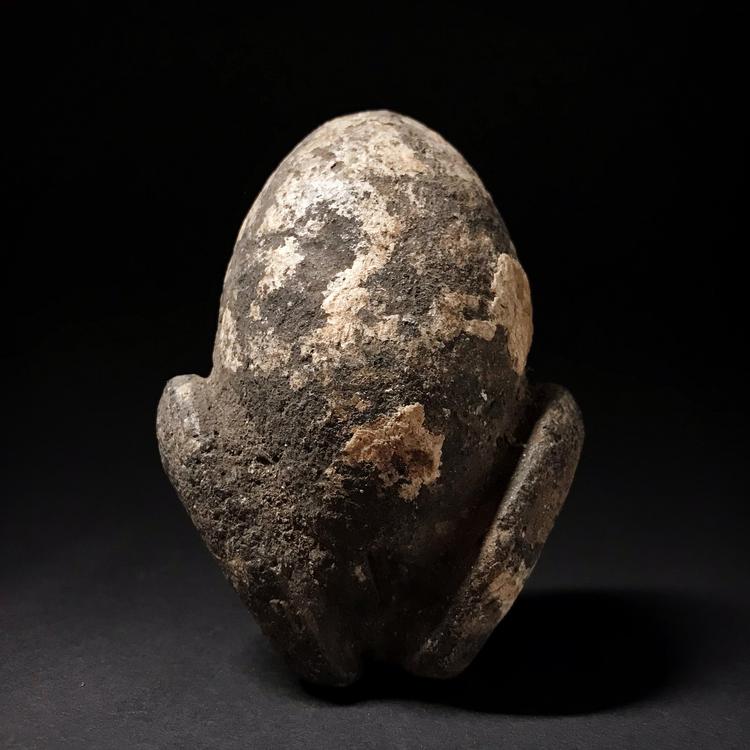Bura Phallic Terracotta Funerary Figure
Bura Phallic Terracotta Funerary Figure
Couldn't load pickup availability
The Bura Asinda-Sikka culture, c. 200-1200AD, Niger or Burkina Faso, West Africa.
This highly unusual and rare small-sized ovoid terracotta figure, crafted between 200-1200 AD, represents the distinctive artistry of the Bura Asinda-Sikka culture of West Africa. Stylized in the form of a frog or phallic symbol, this enigmatic piece features three perforations, adding to its intrigue and potential ritualistic significance.
The Bura culture, centered in the lower Niger River valley of present-day Niger and Burkina Faso, remains one of the most mysterious early civilizations of the Sahel. First discovered in 1975 near Niamey, Niger, the necropolis of Bura-Asinda-Sikka has revealed a wealth of terracotta artifacts, providing glimpses into their funerary and spiritual traditions. Radiocarbon dating suggests that the Bura-Asinda culture thrived from the 3rd to 13th century AD.
Bura artisans are known for their highly distinctive tubular and oval-shaped terracotta urns, as well as round or semi-ovoid vessels, often adorned with mounted horsemen, standing figures, or abstract anthropomorphic motifs. Facial features, coiffures, and symbolic bulges in relief are common, while some urns incorporate phallic and breast representations, possibly linked to fertility or ancestral worship.
The Bura people, believed to be sedentary agriculturists, buried their dead in large urns, placed upside down and clustered together. These funerary vessels contained human remains, textiles, iron arrowheads, and ritual food offerings, underscoring the depth of their spiritual practices.
This remarkable artifact, with its uncommon form and symbolic design, is a rare and collectible testament to the artistic and ceremonial traditions of one of West Africa’s most intriguing ancient civilizations. A prized addition to any serious collection of African antiquities.
Excellent condition. Age-related wear with a few small chips and scratches on surface. Rich encrusted patina. Size approx. 8,5cm x 6,3cm x 3,8cm.
Provenance: Dutch private collection
References and further reading:
Bura Funerary Urns: Niger Terracottas: An Interpretive Limbo?, Michelle Gilbert, African Arts, The MIT Press, Vol. 53, No.1, Spring 2020, pp. 66-75.
Earth and Ore: 2500 Years of African Art in Terra-cotta and Metal, Karl-Ferdinand Schädler, Panterra, January 1, 1997.
Un "Village des Morts" à Bura en Republique du Niger', Boube Gado, in J. Devisse (ed.), Vallées du Niger, Paris: Réunion des Musées Nationaux, 1993, pp. 365-74.
One Hundred Years of Archaeology in Niger, Anne C. Haour, Journal of World Prehistory, Vol.17. No.2, June 2003, pp. 181-234.



-
Shipping
The shipment will be prepared in the course of 3-5 days and dispatched via Posti Group Oyj or purchased item(s) can be picked up from our shop during the store's opening hours (Tarkk’ampujankatu 4, 00140, Helsinki, Finland). Within the Finland, all items are shipped via Posti Group Oyj unless otherwise requested. We pack the items carefully and mainly in recycled materials because we want to save nature. You will receive the tracking number for your items by e-mail.
-
Returns
Returns and exchange will be accepted within fourteen days (14) of receipt at the purchaser’s cost to include freight and packaging. Items must be returned in the same condition as when they were shipped, and will not be accepted if damaged or altered in any way. Please inform us via email (info@gotanmaailma.fi) or by calling +358408408352 before sending. We do not accept returns more than 14 days after delivery.



